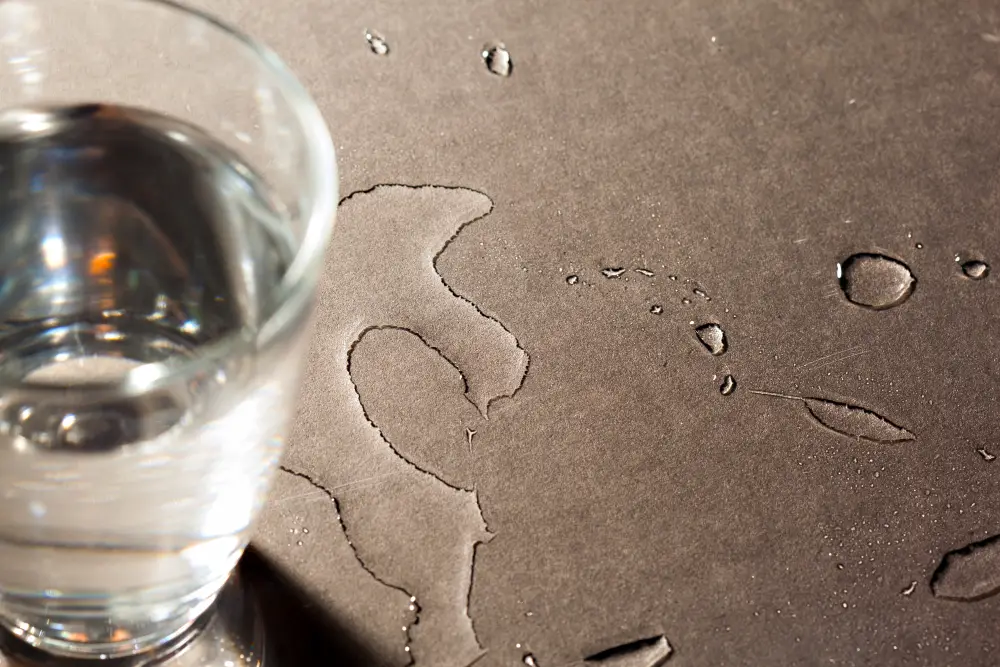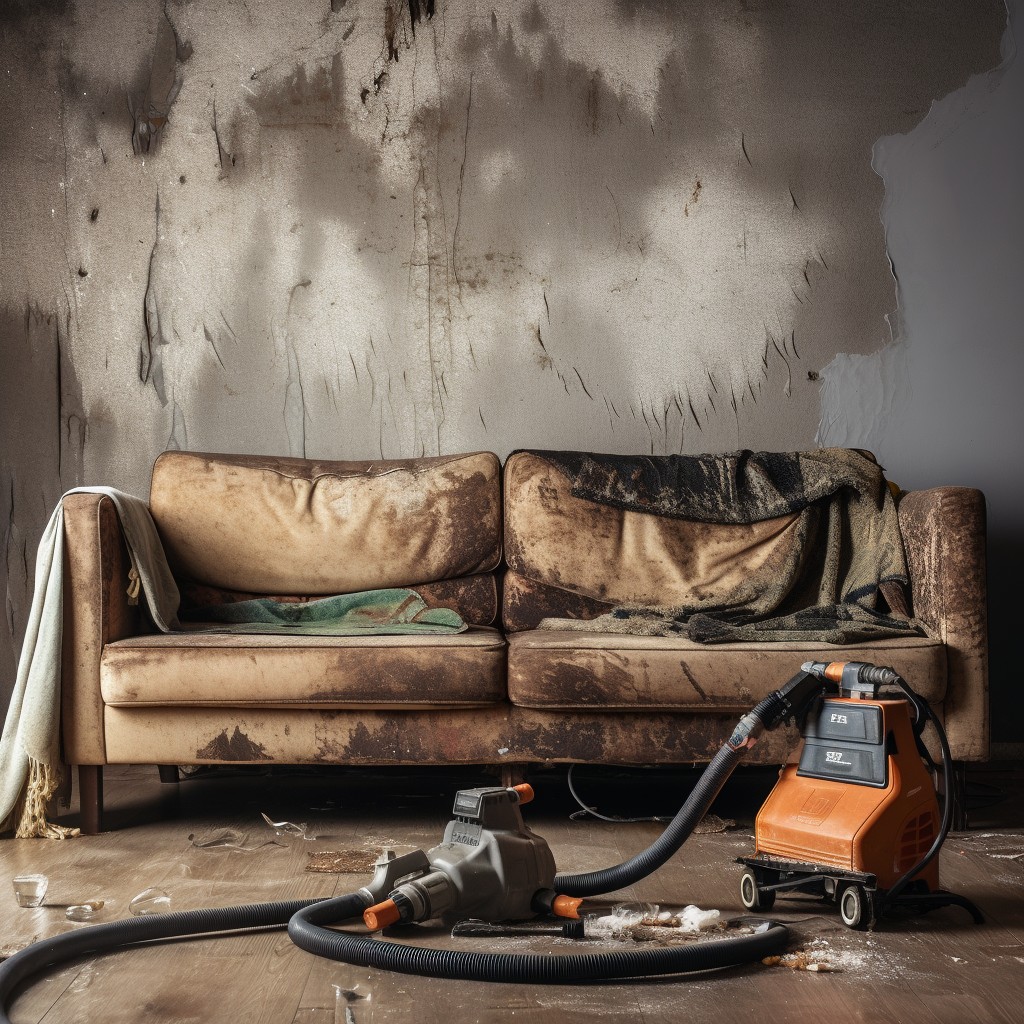Last updated on
Discover the duration it takes for your couch to dry completely after a thorough cleaning in this informative guide.
Have you ever spilled a drink on your couch or had to clean it after a pet accident? If so, you know that one of the biggest concerns is how long it will take for the couch to dry. It can be frustrating to have a wet spot on your furniture for days on end, but fear not! In this article, we’ll dive into everything you need to know about how long it takes for a couch to dry and what factors can affect the drying time.
So grab a cup of coffee and let’s get started!
Key takeaways:
- Couch drying time can vary depending on factors like airflow and humidity.
- Leather couches dry faster than fabrics like microfiber or suede.
- Synthetic fabrics like polyester or nylon dry faster than cotton or linen.
- Proper air circulation and low humidity help speed up drying time.
- Professional drying services can ensure quick and effective results.
Table of Contents
Factors Affecting Couch Drying Time
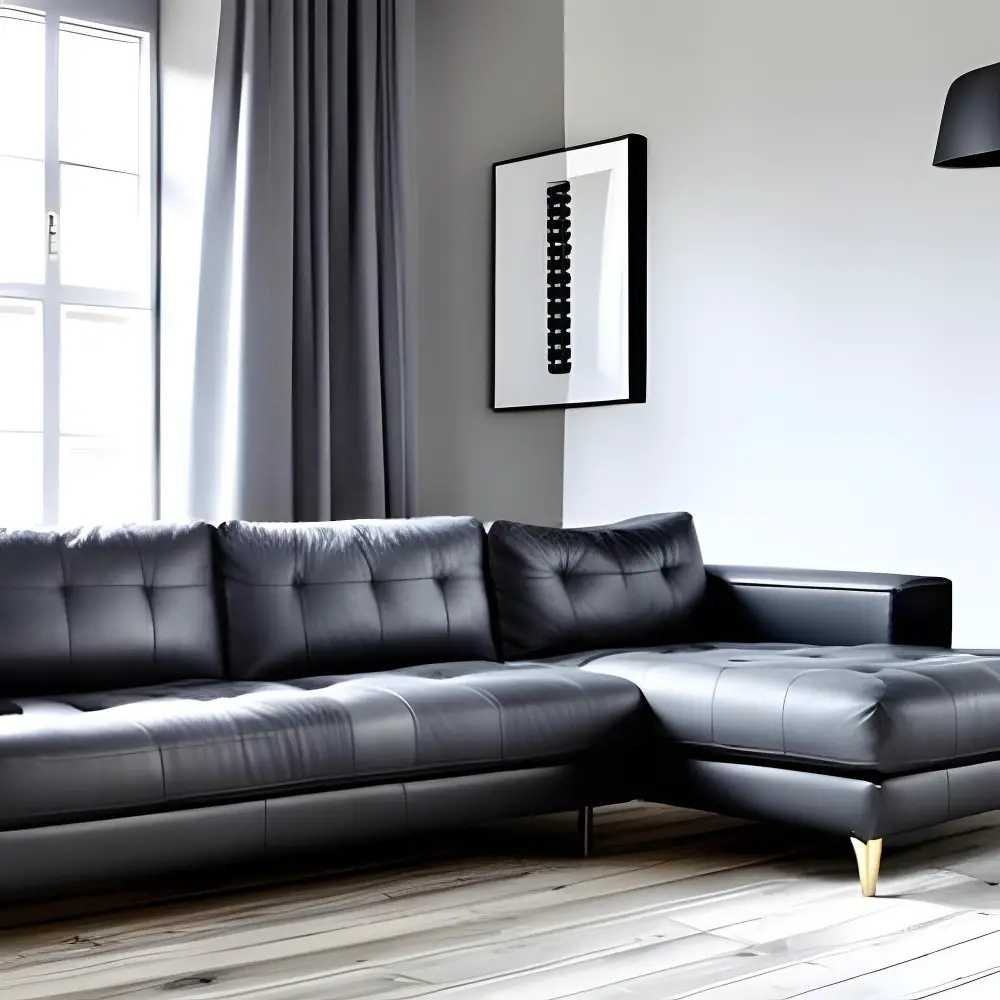
Several factors can affect how long it takes for a couch to dry after cleaning. The type of fabric, the amount of moisture present, and environmental conditions all play a role in determining drying time.
For example, leather couches tend to dry faster than those made from other materials because they are less absorbent. On the other hand, microfiber and suede fabrics may take longer to dry due to their high absorbency levels.
The humidity level in your home or outside environment also affects drying time; higher humidity slows down evaporation rates while lower humidity speeds them up. Air circulation is crucial when it comes to drying furniture quickly as stagnant air can prolong the process.
It’s essential always to consider these factors before starting any cleaning process on your couch so that you know what kind of timeline you’re looking at for complete drying.
Fabric Material Types

Some materials are more absorbent than others, which means they will take longer to dry completely. For example, cotton and linen fabrics tend to hold onto moisture for an extended period compared to synthetic materials like polyester or nylon.
If you have a cotton or linen couch, expect it to take longer than other types of fabrics when drying after cleaning. On the other hand, if your sofa has synthetic fibers such as polyester or nylon upholstery material, then it should dry faster due to their water-resistant properties.
Leather Couch Drying
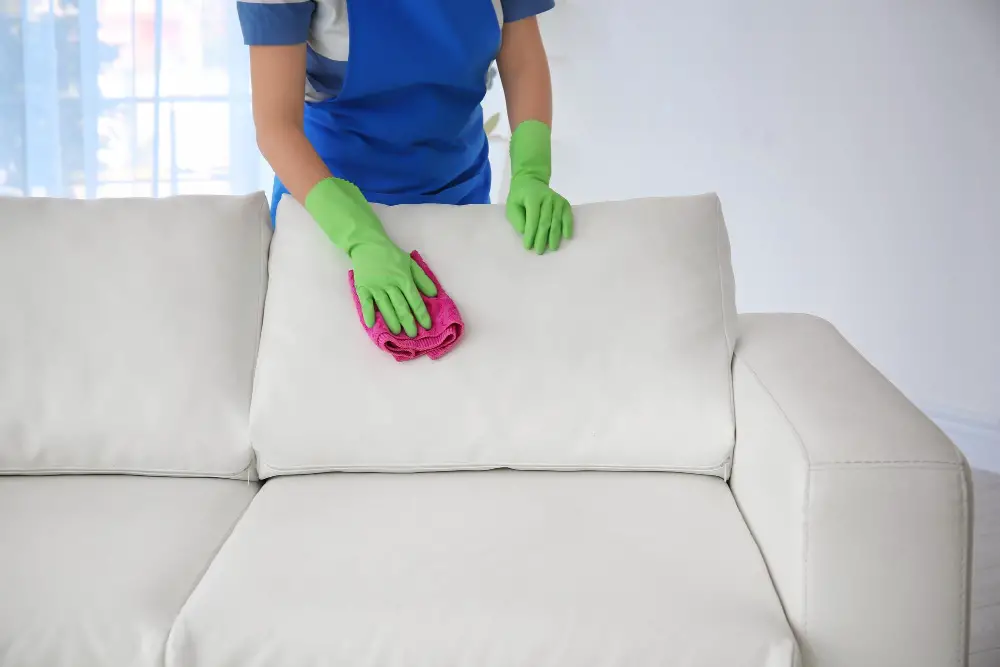
Leather is more sensitive to moisture and requires extra care during the cleaning and drying process. After cleaning your leather couch, it’s essential to dry it as quickly as possible to prevent any water damage or discoloration.
To start, use a clean towel or cloth to blot up any excess water from the surface of your leather couch. Then place some fans around the area where you cleaned so that air circulates freely over and under your furniture piece.
Avoid using heat sources like hairdryers or heaters directly on your leather sofa since they can cause cracking in its material due to excessive heat exposure. Once all visible moisture has been removed from its surface, apply a conditioner specifically designed for use on leathers; this will help restore natural oils lost during cleaning while also protecting against future spills by creating an invisible barrier between liquids and upholstery fibers.
Microfiber Couch Drying
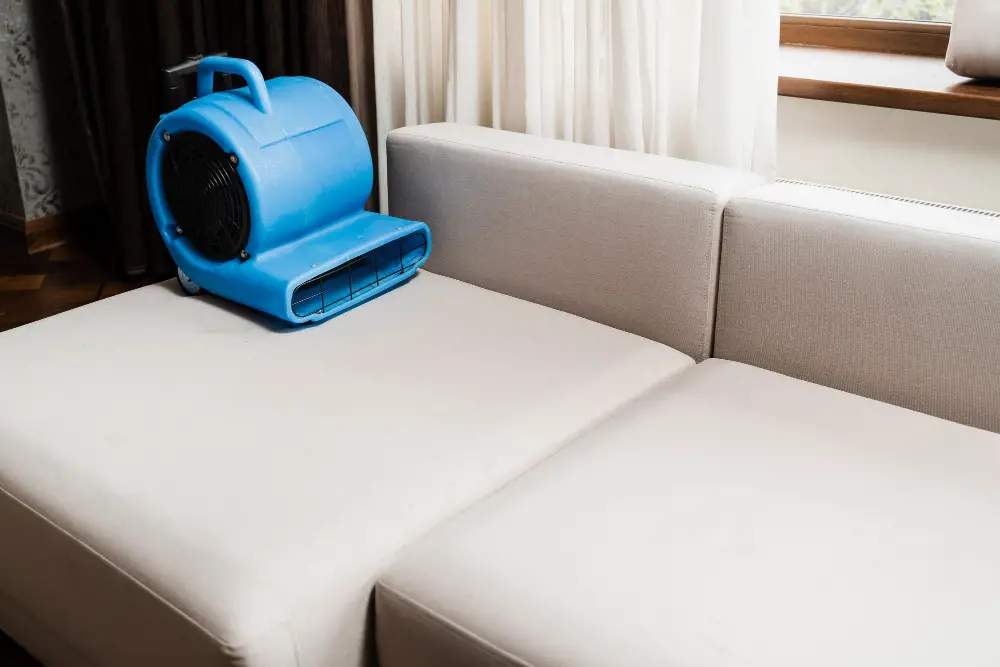
When it comes to drying them after cleaning, the process can be a bit tricky. Microfiber is known for its ability to absorb moisture quickly, which means that it can take longer than other fabrics to dry completely.
To speed up the drying time of your microfiber couch, start by blotting up as much excess water as possible with a clean towel or cloth. Avoid rubbing or scrubbing the fabric too hard as this could damage the fibers and cause pilling.
Next, use a fan or open windows in your home to increase air circulation around the couch. This will help evaporate any remaining moisture from deep within the fabric.
If you’re still having trouble getting your microfiber couch completely dry after several hours of air-drying time, consider using an upholstery cleaner specifically designed for this type of material. These cleaners often contain special ingredients that help break down stubborn stains while also speeding up drying times.
Suede Couch Drying
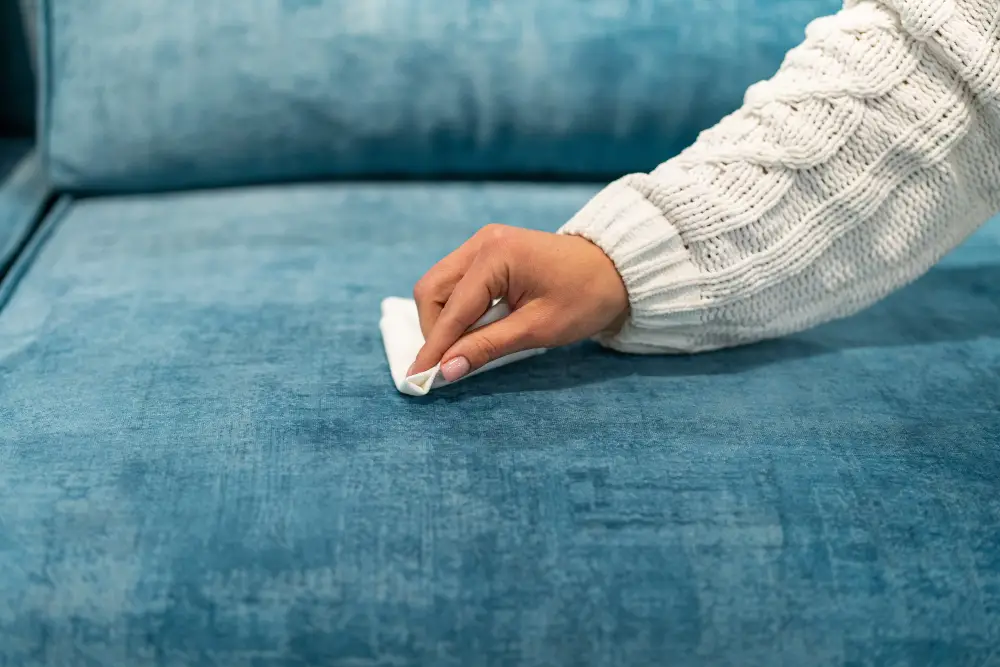
They can be challenging to clean and dry due to the delicate nature of the material. When it comes to drying suede couches, patience is key as rushing the process can cause permanent damage.
To begin with, use a clean cloth or towel to blot up any excess moisture from spills or stains on your suede couch. Avoid rubbing as this will only push water deeper into the fabric fibers.
Next, place some paper towels over the wet area and press down gently with your hands. The paper towels will absorb any remaining moisture from within the fabric fibers.
After that, leave your suede couch in a well-ventilated room away from direct sunlight until it dries completely. Do not use heaters or fans directly on it as this may cause shrinkage or discoloration of its surface.
If you’re dealing with stubborn stains that won’t come out easily even after cleaning them thoroughly using appropriate methods like steam cleaning; consider hiring professional upholstery cleaners who have experience handling delicate fabrics such as suede.
Upholstery Drying Times

Different materials absorb moisture at different rates, and some may require more time to dry than others. For instance, a cotton or linen fabric will take longer to dry compared to synthetic fabrics like polyester or nylon.
The thickness of the upholstery also plays a role in determining how long it takes for your couch to dry completely. Thick cushions and padding can trap moisture inside for an extended period.
It’s essential always to check with the manufacturer’s instructions before cleaning any upholstered furniture as they may have specific guidelines on how best you should clean them without damaging them.
Understanding that different types of upholstery have varying drying times is crucial when cleaning your couches after spills or accidents occur.
Weather and Environmental Influences
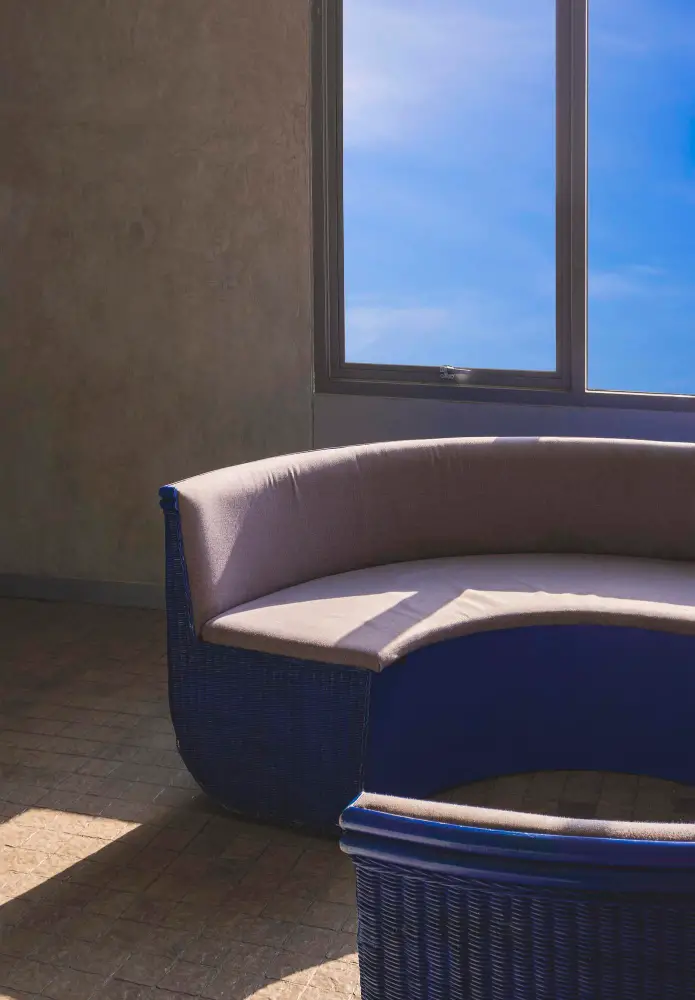
If you live in a humid area, it will take longer for your couch to dry completely. Humidity slows down the evaporation process, which means that moisture will linger on your furniture for an extended period.
Similarly, if you’re cleaning your couch during rainy or damp seasons, it may take longer to dry due to increased humidity levels in the air. On the other hand, if you’re cleaning during hot summer months with low humidity levels or using heating systems indoors during winter months when there is less moisture in the air than usual; this could speed up drying times.
It’s essential to consider these factors before starting any upholstery cleaning project so that you can plan accordingly and avoid any inconvenience caused by prolonged wetness on furniture surfaces.
Weather patterns play a significant role in determining how long it takes for a couch to dry after thorough cleaning.
Humidity’s Role

High humidity levels can slow down the evaporation process, making it take longer for your furniture to dry completely. On the other hand, low humidity levels can speed up drying times by allowing moisture to evaporate more quickly.
If you live in an area with high humidity or are experiencing rainy weather, it may take longer for your couch to dry after cleaning. In this case, you might want to consider using a dehumidifier or air conditioner in the room where your furniture is located.
It’s important not to rush through this process as dampness left behind on upholstery can lead to mold growth and unpleasant odors over time. So be patient and allow enough time for proper drying before using or sitting on any recently cleaned furniture pieces.
Air Circulation Influence

If you have a fan or air conditioning unit, turn them on to increase air circulation around the couch. The moving air will help evaporate moisture from the fabric faster and reduce drying time.
On the other hand, if there is no proper ventilation in your room, it may take longer for your sofa to dry completely. In such cases, consider opening windows or doors to allow fresh air into space.
It’s also essential not to cover up a damp couch with blankets or cushions as this will slow down evaporation and prolong drying time.
Good airflow is crucial when trying to speed up furniture drying times after cleaning spills or pet accidents.
Methods to Speed Up Couch Drying
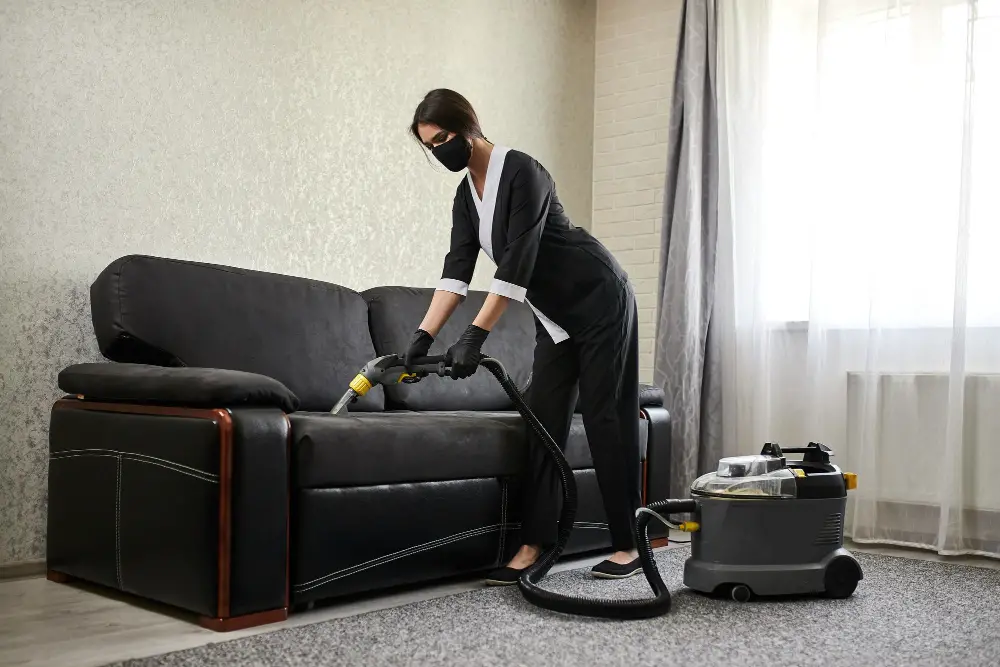
One of the most effective ways is to use fans or heaters. Place a fan near the wet spot and turn it on high to increase air circulation around the area.
You can also use a space heater or hairdryer set on low heat, but be careful not to hold it too close as this could damage delicate fabrics.
Another DIY technique is using absorbent materials like towels or paper towels placed over damp areas and pressing down gently with your hands until they soak up excess moisture. Repeat this process until no more water comes out.
Professional drying services are also available if you want guaranteed results without risking any damage from DIY techniques. They have specialized equipment designed for quick drying times and will ensure that your couch dries thoroughly without any mold growth.
Use of Fans or Heaters

Fans help circulate air around the wet areas, which helps evaporate moisture faster. You can use a ceiling fan, standing fan or even a handheld one to direct airflow towards your couch.
Heaters are also useful in speeding up drying time as they increase temperature and reduce humidity levels in the room. However, it’s important not to place them too close to your furniture as this could cause damage.
When using fans or heaters, ensure that there is proper ventilation in the room so that moist air can escape and dry air can enter. This will prevent mold growth on both your furniture and walls.
DIY Couch Drying Techniques

First and foremost, remove any excess moisture from the surface of the couch using a clean towel or cloth. You can also use paper towels or even a wet/dry vacuum to extract as much water as possible.
Next, open windows and doors in the room where your couch is located to increase air circulation. If it’s humid outside, however, this may not be an effective method for drying your furniture.
Another option is to use fans or heaters strategically placed around the room near your damp sofa. Fans will help circulate air while heaters will provide warmth that helps evaporate moisture faster.
For leather sofas specifically, avoid using heat sources like hairdryers which could cause cracking on its surface; instead opt for natural drying methods such as placing it under shade with good ventilation until completely dry.
Professional Drying Services
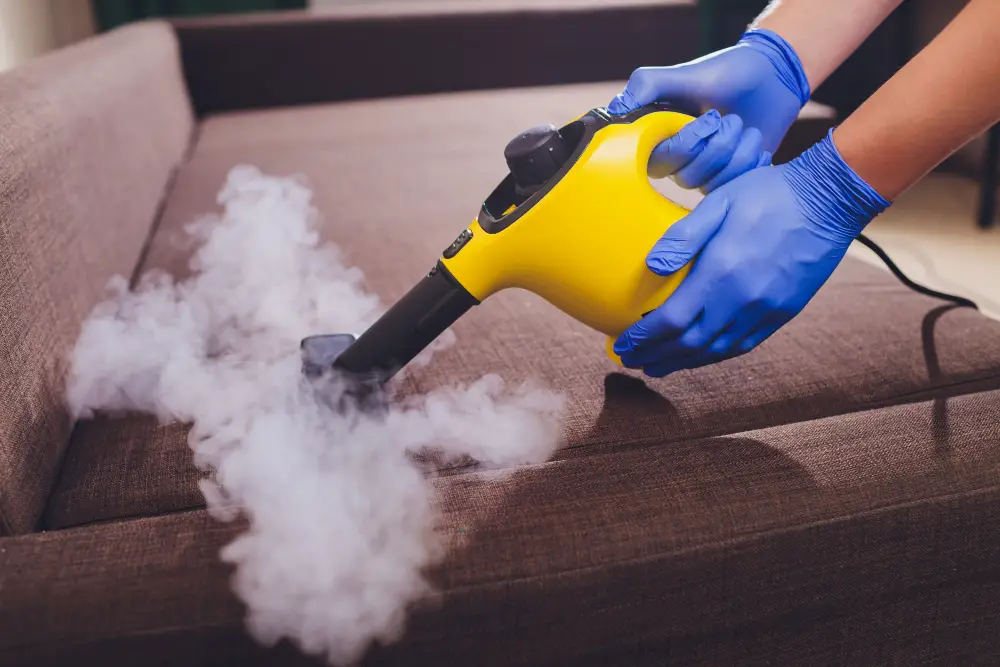
These companies have specialized equipment and expertise to dry your furniture quickly and effectively without causing any damage.
Professional drying services can also help prevent mold growth by ensuring that all moisture is removed from the couch. They use high-powered fans and dehumidifiers to speed up the process, which means you’ll have a dry couch in no time.
While professional drying services can be more expensive than DIY methods, they are often worth it for those who want peace of mind knowing their furniture is being handled by experts. Just make sure to do your research beforehand and choose a reputable company with good reviews.
Remember: whether you decide to go the DIY route or hire professionals, always prioritize safety first when dealing with wet upholstery.
Drying Time for Different Cleaning Methods
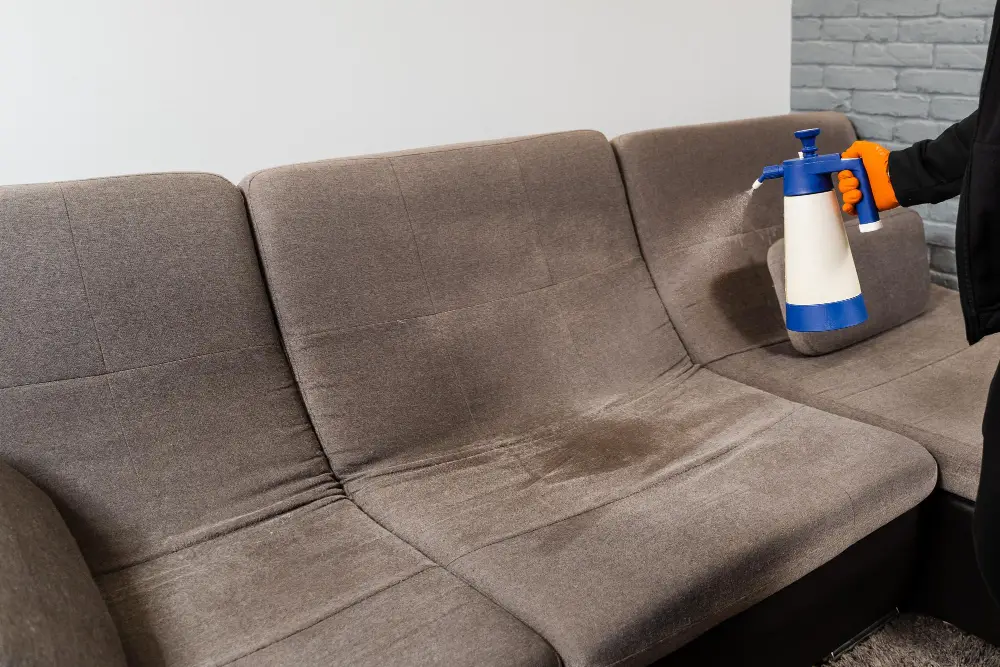
For instance, steam cleaning involves using hot water to clean and sanitize the fabric or leather surface. This method is effective in removing dirt, stains, and odors from your couch but may take longer to dry compared to other techniques.
On the other hand, spot-cleaning with a damp cloth or sponge may not require much drying time as you only target specific areas that need cleaning. However, if you use too much water during spot-cleaning or saturate an area with a cleaner solution accidentally, it could prolong the drying process.
It’s essential to note that regardless of which method you choose for cleaning your couch; proper ventilation is crucial for quick-drying results. Open windows and doors in well-ventilated rooms help air circulate freely around furniture surfaces hence speeding up evaporation.
Steam Cleaning Effects
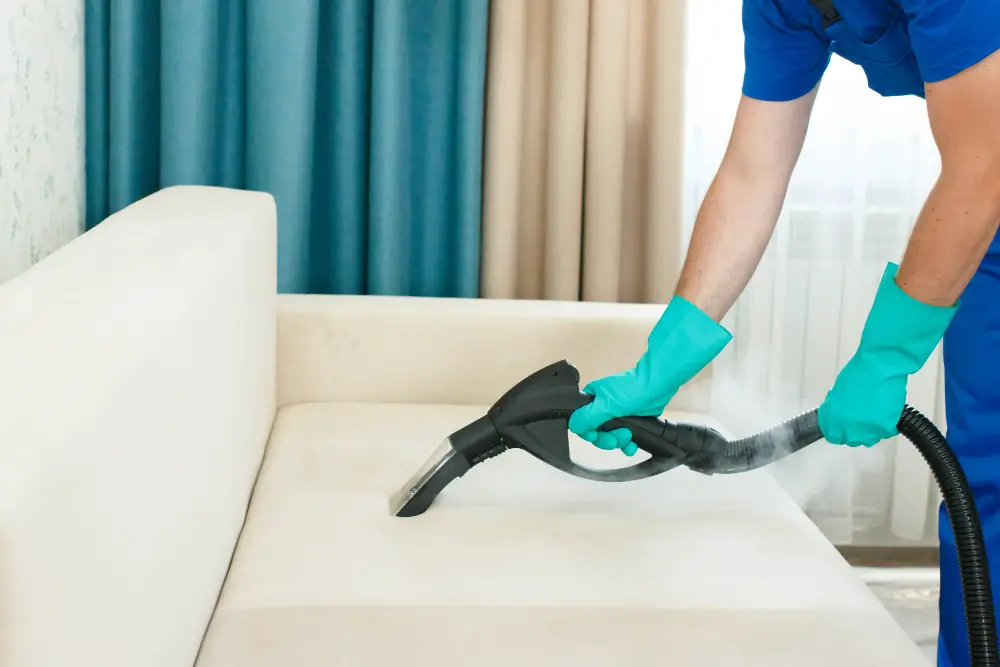
Steam cleaning uses hot water vapor to penetrate deep into the fabric of your couch, breaking down dirt and grime that may be trapped inside. While this method is effective at removing stains and odors from your furniture, it also adds moisture to the upholstery.
The amount of time it takes for a steam-cleaned couch to dry will depend on several factors such as humidity levels in your home or outdoor environment. If you live in a humid climate or are experiencing high humidity levels due to weather conditions like rain or snowfall, then expect longer drying times.
To speed up the process after steam cleaning your sofa set; open windows if possible (if not too humid), turn on fans around them (ceiling fan works best) so air circulates better around them which helps evaporate any remaining moisture faster than usual.
Stain Removal and Drying

It’s essential to remove any stains before attempting to dry your couch. The type of stain will determine the cleaning method you should use.
For example, if it’s a liquid spill like wine or coffee, blot up as much of the liquid as possible with a clean cloth or paper towel. Avoid rubbing because this can push the stain deeper into the fabric fibers.
Next, apply an appropriate cleaning solution according to your couch material and follow instructions carefully. After removing all traces of stains from your furniture piece using recommended methods for each type of fabric material used in making it; allow enough time for air-drying before sitting on them again.
Managing Moisture During the Drying Process

If not handled correctly, excess moisture can lead to mold growth and unpleasant odors. To manage moisture effectively, start by using a clean towel or cloth to blot up as much water as possible from the wet area of your couch.
Next, use a dry towel or paper towels to absorb any remaining dampness.
If you’re dealing with a large amount of water on your couch, consider using an industrial-strength wet/dry vacuum cleaner designed for upholstery cleaning. These vacuums are powerful enough to extract most of the water from deep within the cushions and fabric.
Another way to manage moisture during drying is by placing fans around your furniture piece in strategic positions that promote air circulation over it while it dries out completely. It’s important also that you avoid exposing your furniture directly under sunlight since this could cause fading or discoloration on some fabrics like leather and suede.
Preventing Mold Growth
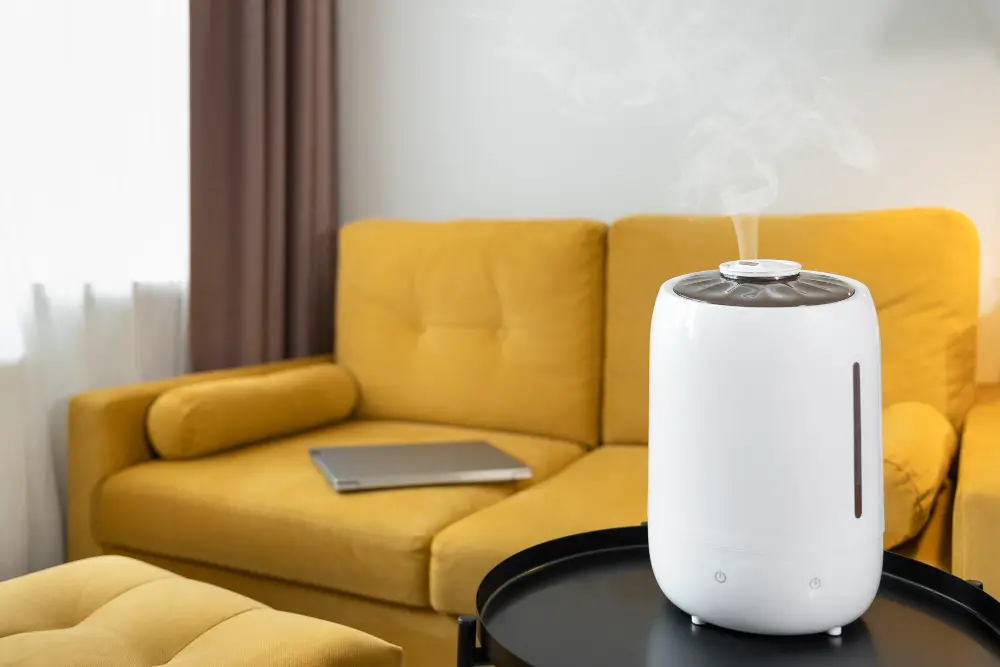
Mold thrives in damp environments and can cause health problems such as allergies and respiratory issues. To prevent mold growth on your couch, ensure that it’s completely dry before using or covering it with anything.
If you notice any signs of mold on your couch, take immediate action to remove it. You can use a mixture of water and vinegar or hydrogen peroxide to clean the affected area thoroughly.
Avoid using bleach as this may damage the fabric material.
To prevent future occurrences of mold growth on your furniture, keep humidity levels low by running a dehumidifier in humid weather conditions or placing moisture-absorbing packets around the room where you keep your sofa.
Precautions for Drying Delicate Fabrics

Delicate fabrics such as silk or velvet can easily be damaged by heat or excessive moisture. To avoid damaging your couch during the drying process, consider using a low-heat setting on your dryer or air-drying instead of machine-drying.
When air-drying delicate fabrics, make sure to lay them flat on a clean surface and avoid hanging them up as this can cause stretching and distortion of the fabric. Keep in mind that some cleaning products may not be suitable for use with delicate fabrics; always check the label before applying any product.
Taking proper precautions when drying your couch is crucial to ensure its longevity and prevent damage from occurring.
Maintenance Tips for Keeping Couches Fresh and Dry
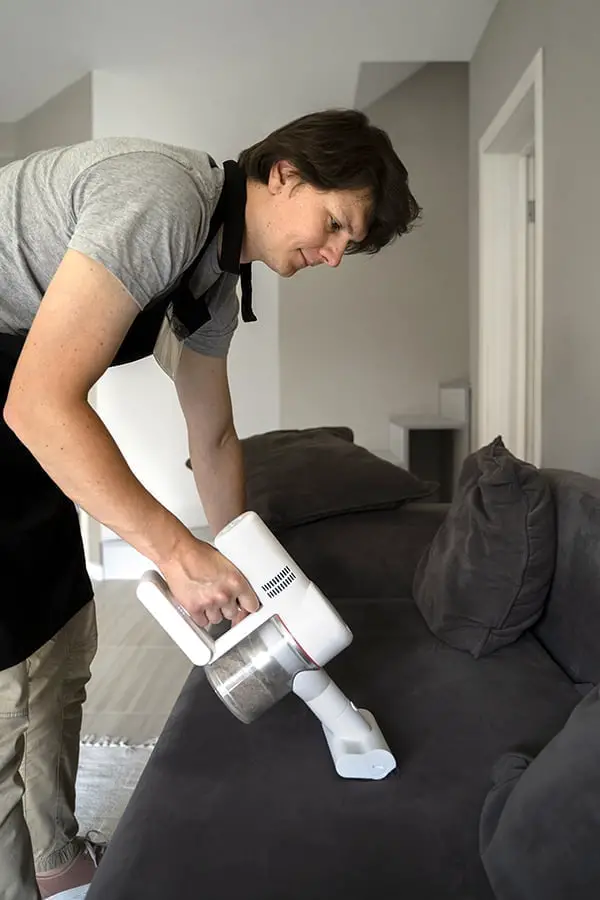
Regular maintenance can help prevent spills from becoming stains, which will make cleaning easier in the future.
One of the easiest ways to maintain your couch is by vacuuming regularly. Dust and dirt can accumulate on upholstery over time, making it look dingy or dull.
By vacuuming once a week with an upholstery attachment, you’ll remove any loose debris before they settle into the fabric.
Another way to keep your couch clean is by using slipcovers or throws. These are especially useful if you have pets or children who may spill drinks or food on the furniture frequently.
Lastly, consider investing in a dehumidifier if you live in an area with high humidity levels. High moisture content can cause mold growth on fabrics like cotton and linen; therefore reducing humidity levels will help prevent this problem from occurring.
By following these simple tips regularly, not only will your sofa stay looking great but also remain fresh-smelling while drying faster after cleaning!
FAQ
How long do couches need to dry?
Couches typically need 4-6 hours to dry, but drying time may vary depending on factors such as airflow and humidity.
How do you dry water out of a couch?
To dry water out of a couch, use a fabric steamer or steam iron, as it effectively removes water stains, loosens dirt and particles in soft fibers, and kills hidden bacteria and mold with its high heat.
How long does it take steam cleaned couch to dry?
Steam cleaned couches typically dry within 2 to 6 hours, depending on the fabric type.
What factors can impact the drying time of a couch after cleaning?
Drying time of a couch after cleaning can be impacted by factors such as humidity, temperature, air circulation, and the type of cleaning method used.
Are there any quick methods to speed up the drying process of a couch?
Yes, to speed up the drying process of a couch, use fans, open windows, or a hairdryer to expedite evaporation and air circulation.
How can humidity levels influence the drying time of a cleaned couch?
Higher humidity levels can prolong the drying time of a cleaned couch as moisture in the air reduces the rate of evaporation.
You may also like to read:
